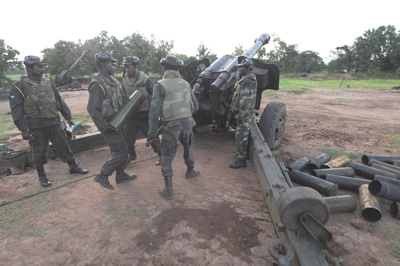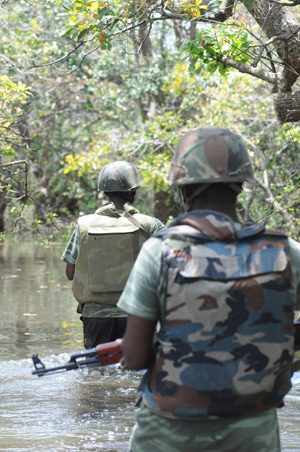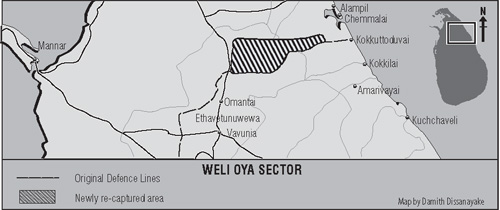
President reviews progress of war
With just two weeks to go for the National New Year, what portends in the battlefields of the Wanni engaged the attention of both political and military leaders this week. It was not merely a task of assessing performance on the ground. More importantly, the move was to determine how the progress or the lack of it would influence all other activity. They include development work, festivity in the coming weeks, and the upcoming Eastern Provincial Council elections. With these factors in mind, President Mahinda Rajapaksa invited senior officers of the Army and the Navy in the Northern and Eastern theatres for the National Security Council meeting on Friday at Temple Trees. They were later entertained to lunch. The meeting usually held on Wednesday was put off by two days in view of the death of the mother of the first lady, Shiranthi Rajapaksa. Among those taking part were: Security Forces Commander (Jaffna), Major General G.A. Chandrasiri, Major General Jagath Dias (GOC - 57 Division), Brigadier Shavindra Silva (Commander Task Force 1 and Commander, Commando Regiment), Brigadier Nandana Udawatte (Officiating GOC, 59 Division), Rear Admiral Tissera Samarasinghe, (Commander, Northern Naval Area) and Rear Admiral Ananda Peiris (Commander, Eastern Naval Area). A technical glitch nearly delayed the arrival of Maj. Gen. Chandrasiri from Palaly. The Air Force had to fly its Hercules C-130 transport plane to bring Maj. Gen. Chandrasiri to Palaly from where he was airlifted to Colombo in a helicopter. Sessions of the National Security Council are held behind closed doors and deliberations usually remain a secret. This is in view of national security concerns. The Sunday Times will not therefore comment on the areas of discussion or on matters focused. However, some issues of public interest pieced together following conversations with those invited can be revealed. Most of them were of the view that an unexpected enemy - incessant rains - had hampered offensive operations in the Wanni. These were both in the Mannar and Weli Oya sectors. They opined that Tiger guerrillas "have been weakened" and they "were on the retreat." Troops were undeterred and braving all the odds, but the conditions, they said, were difficult. The bunkers were flooded. Air activity, like surveillance, close air support, casualty evacuation, among others, were being hampered by bad weather. Roads were muddy. Deployment of armoured vehicles was posing a problem. Senior officers showed photographs of soldiers wading in the floodwaters or engaged in other tasks braving the floods.
Offensive military operations in the Mannar sector began on July 2 last year. A second flank in the north-eastern Wanni, inland from the coast, ahead of Ethawetunuwewa and Janakapura, began on January 7, this year. "President Rajapaksa showed very keen interest in what we said. He raised a number of pertinent questions," said a senior Army officer who spoke on grounds of anonymity. He said he was well versed on the ground realities and made copious personal notes of the observations they made. Understandably, the President, who is the Minister of Defence and Commander-in-Chief, is conscious of the intensified efforts to both strengthen and modernise the armed forces since he took office. Now that the Government's "war on terror," in the ongoing Eelam War IV is under way, he would naturally want to ascertain the progress made in the light of heavy expenditure incurred on defence. Some aspects relating to this cannot be commented upon due to personal constraints. They include the all-important subject of casualties. A senior Army officer had raised issue over Rupavahini, the national television network, not airing visuals they sent regularly depicting successes in the battlefield. Instead, file footage of previous military activity was being broadcast. One source said an angry President Rajapaksa promptly summoned officials from the TV station to personally hear the Army officer's charges. The officials in question had not contested the allegations but said arrangements had now been made to improve coverage in the battle areas. President Rajapaksa had called for an immediate report on the complaint made by the Army officer. Earlier, Media Minister Anura Priyadarshana Yapa had ordered an inquiry into how a "crawler" at the bottom of the screen had erroneously reported the death of a close member of the President's family when in fact, it was his mother-in-law who had passed away. This inquiry is to ascertain whether this was an act of sabotage. However, senior officials at Rupavahini insisted, "this was a bona fide error though a serious one." Both the Army and Navy officers, the sources said, gave detailed accounts of their activity. They said troops were making gains when the inclement weather conditions literally stalled activity. However, they said that operations would continue to weaken Tiger guerrillas. In this backdrop, concerns grew at Navy Headquarters in Colombo on the attack on a Dvora Fast Attack Craft. As reported last week, an explosion engulfed the locally built FAC in a ball of fire and it sank immediately. The Sea Tiger attack on the naval craft took place on March 22 in the deep seas off Nayaru, which lies near the Tiger guerrilla stronghold of Mullaitivu. Early this week, naval craft on search-and-rescue operations discovered the bodies of three of their sailors. Last Thursday, the Navy in the seas off Point Pedro found parts of a female body, suspected to be that of a guerrilla cadre involved in the attack. The fate of seven other Navy sailors is still not known. According to a senior official at Navy Headquarters in Colombo, an unknown number of sailors were in guerrilla custody. However, this claim cannot be independently verified. Contrary to earlier thinking that the Dvora (437) built by Colombo Dockyard was hit by a sea mine, there is a growing belief that a human torpedo was the cause. The Sunday Times has learnt from highly placed Navy sources that at least three guerrillas directed an engine driven (floating or submerged) contraption at the Dvora and banged on it enveloping it in a ball of fire. It sank. The Tamilnet web site, however, claimed the guerrillas then "engaged in a confrontation" with the Navy "that lasted for 45 minutes." The claim to suggest that it was a gun battle at sea, Navy sources say, is to cover up the fact that they possess a new capability. In fact, neither the crew of the second Dvora nor survivors from the one that was destroyed, as reported last week, were able to say how the incident occurred. There was no exchange of fire and no evidence electronically to confirm that there was indeed a confrontation. The frequency of naval encounters in the north-eastern seas is increasing. Navy officials say this is because the seas are now turning calm and will be even calmer in the coming weeks. In the light of this, both the Northern and Eastern Commands of the Navy have alerted their personnel to remain on high alert. The actions of a senior Police officer in the Batticaloa district have come under inquiry after an incident in which two policemen were killed. This was due to a claymore mine attack by Tiger guerrillas at Manalpiddy (near Kokkadicholai), seven kilometres from the Batticaloa town. The incident in this area had come when a police party was escorting a Japanese national to inspect a project. The officer is said to have authorised provision of escort without any clearance from higher authorities. In the light of the ongoing military offensives in the Wanni, the Government is giving priority to the requirements of the Security Forces and the Police. In this regard, greater significance is being attached to the inclusion of two members from the defence sector in Prime Minister, Ratnasiri Wickremanayake's visit to Israel. They are Ranjit Wickremasinghe, Chief Executive Officer of Lanka Logistics Ltd. and Brigadier Udaya Perera, Director, Operations at Army Headquarters. The Sunday Times learns Mr. Wickremanayake had a meeting with former Prime Minister and now Defence Minister, Ehud Barak in Israel. The Sri Lankan team also visited the state owned Israel Aerospace Industries (IAI - formerly known as Israel Aircraft Industries). Yair Ramati, Deputy Director (Marketing) at IAI received them. Among the many military products, the IAI manufactures Super Dvora (Bee) Fast Attack Craft and Unmanned Aerial Vehicles (UAVs). Premier Wickremanayake and his entourage have since returned to Sri Lanka. This week's events show that charting the "war on terror" on the correct course is one of Government's top priorities. In meeting the field commanders, President Rajapaksa has demonstrated that he is in personal control and will closely monitor developments. Thus, the coming weeks and months of ongoing Eelam War IV will remain critical for Sri Lanka's future. |
|
||||||
|| Front
Page | News | Editorial | Columns | Sports | Plus | Financial
Times | International | Mirror | TV
Times | Funday
Times || |
| |
Reproduction of articles permitted when used without any alterations to contents and a link to the source page.
|
© Copyright
2008 | Wijeya
Newspapers Ltd.Colombo. Sri Lanka. All Rights Reserved. |


 Just 24 hours after the attack destroying the Dvora, Sea Tigers (on Sunday) engaged a naval patrol in the seas off Kallarawa (north of Tiriyai) in the Trincomalee district. A flotilla of ten Sea Tiger boats accompanied by six "suicide craft", Navy officials said, engaged a Navy patrol for over three hours from midnight. One guerrilla vessel was "badly damaged" and they withdrew from the area. There were no casualties or damage to the Navy, they added. Beginning midnight yesterday, a Navy patrol was also locked in sea battles with the guerrillas.
Just 24 hours after the attack destroying the Dvora, Sea Tigers (on Sunday) engaged a naval patrol in the seas off Kallarawa (north of Tiriyai) in the Trincomalee district. A flotilla of ten Sea Tiger boats accompanied by six "suicide craft", Navy officials said, engaged a Navy patrol for over three hours from midnight. One guerrilla vessel was "badly damaged" and they withdrew from the area. There were no casualties or damage to the Navy, they added. Beginning midnight yesterday, a Navy patrol was also locked in sea battles with the guerrillas.